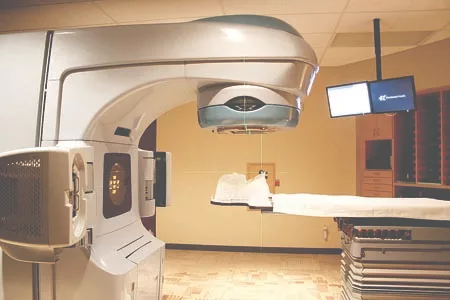
Home » Kootenai Cancer Center puts tight beam on brain tumors
Kootenai Cancer Center puts tight beam on brain tumors
Procedure uses enhanced linear accelerator to avoid damaging healthy tissue

May 5, 2011
A medical team at the Kootenai Cancer Center, in Post Falls, now is treating certain brain tumors with high-dose radiation using a $4 million linear accelerator that's specially equipped to perform what's called stereotactic radiosurgery.
The outpatient procedure involves aiming tightly focused beams of radiation at tumors without harming surrounding healthy tissue, says Dr. Karie-Lynn Kelly, a radiation oncologist.
Although the procedure doesn't involve any incisions, "it's called surgery because the changes in the brain are as if surgery were performed," Kelly says.
Kelly works closely with neurosurgeon Dr. William Ganz, as well as a medical physicist, a dosimetrist, and radiation therapists. Ganz reviews the treatment plan and assists Kelly in defining the appropriate radiation volume for the target, Kelly says.
"The dosimetrist calculates the time it will take for the linear accelerator to deliver the prescribed dose of radiation, and the physicist calibrates the machine and verifies the calculations," she says.
Stereotactic radiosurgery performed at the cancer center generally is used to treat brain lesions less than three centimeters in diameter, and it is most effective on certain metastatic tumors, Kelly says. A metastatic tumor originates from a primary cancer, such as lung cancer, through which cancer cells are carried from the primary tumor to the brain through the bloodstream, she says.
Patients typically have gone through a combination of conventional surgery, radiation therapy, and chemotherapy treatments for the primary cancer prior to diagnosis and treatment of the metastatic brain cancer, Kelly says.
The linear accelerator at the Kootenai Cancer Center is the Trilogy model manufactured by Varian Medical Systems Inc., of Palo Alto, Calif., and its stereotactic radiosurgery component was developed by Brainlab AG, of Germany. The equipment was installed at the center in Post Falls, at 1440 E. Mullan, when the center was constructed in 2009, and Kelly, Ganz, and the medical team have been performing the stereotactic radiosurgery there since last July, following extensive training.
Providence Sacred Heart Medical Center & Children's Hospital also acquired a Trinity-model linear accelerator and Brainlab attachment in 2009 and offers stereotactic radiosurgery here.
The enhanced linear accelerator isn't the only type of equipment that uses ionizing radiation to control certain brain tumors. Another high-tech machine, called a Gamma Knife, does a similar procedure using a specialized helmet to deliver gamma radiation. It also pinpoints the target area with a high degree of accuracy while sparing surrounding tissue. Such equipment is used here by Gamma Knife of Spokane, located at the Deaconess Health & Education Center.
For treating brain tumors, the linear-accelerator process involves molding a mask of the patient's head using a pliable mesh material that hardens in about an hour. The mask snaps into place on the procedure table to keep the patient's head immobile. The linear accelerator is outfitted with computed tomography (CT) imaging equipment, which enables technicians to create pre-treatment images so physicians can access the precise location of the tumor while the patient is in place on the procedure table.
No anesthesia is needed, although some patients who exhibit signs of claustrophobia are given a mild sedative.
During stereotactic radiosurgery, which takes 90 minutes to two hours, the patient is alone in the procedure room, which is shielded by 7-foot-thick concrete walls to prevent radiation exposure to the center's staff and visitors, Kelly says.
The medical team monitors the procedure in a separate control room via several computer screens, which provide a live video feed of the patient and equipment, and the technical status of the procedure.
The equipment speeds up subatomic particles which collide with a high-density material, such as tungsten, to create a beam of high-energy X-ray radiation. The beam exits a part of the accelerator called a gantry, which rotates around the patient, stopping in five to nine locations to emit the beam toward the targeted tumor.
Radiation in high doses damages the DNA, or genetic information-carrying material in cancer cells, preventing them from growing and reproducing, Kelly says.
Individually, the radiation beams are too weak to damage cells they pass through, but the combined radiation of all of the beams, which intersect at the location of the tumor, delivers a lethal dose of radiation to the abnormal cells, she says.
The procedure has proven most effective in controlling metastatic brain tumors caused by lung cancer and breast cancer, she says. It also has controlled most metastatic brain tumors caused by renal cancer and melanomas, and about half of such tumors caused by all other cancers, she says.
A tumor is considered controlled when it stops growing, and irradiated tumors often begin to shrink in size within a few months following the procedure.
"An advantage of the procedure is that candidates for it don't have to undergo whole-brain radiation, which can cause permanent damage and diminish the patient's cognitive abilities," she says.
Side effects of stereotactic radiosurgery can include weakness, seizures, difficulty in speaking, and bleeding within the brain, Kelly says.
The procedure costs less than conventional surgical removal of the tumor, and it's covered by most insurance providers, she says.
Primary cancer tumors in the brain generally are treated with conventional surgery and radiation therapy, Kelly says, and stereotactic radiosurgery at times is used as a secondary course of treatment.
Latest News
Related Articles




_web.webp?t=1764835652)